Breaking the lines: Sky Sports unveils mixed reality presentation studio for Monday Night Football and US Open tennis coverage
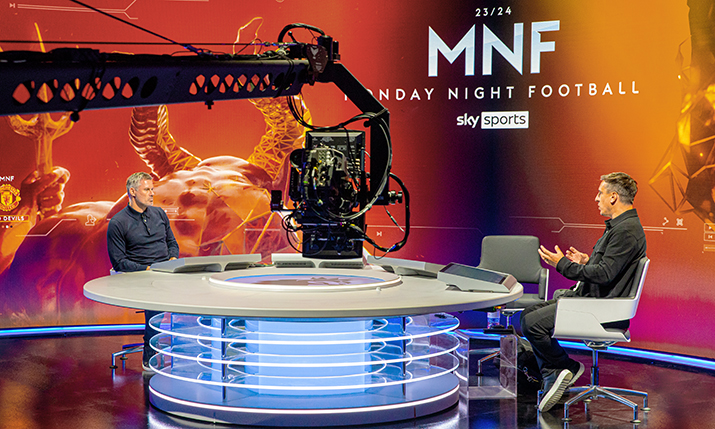
Sky Sports has converted two studio spaces at its Osterley campus in West London into a single flexible-use mixed-reality presentation studio that will be used for its flagship Monday Night Football (MNF) show as well as 2023 US Open tennis coverage and, in the future, other sports output.
The studio, which was designed and engineered in-house, includes four distinct physical spaces, an extensive LED floor and LED walls, AR and VR capabilities, and a BatCam wire cam system.
Take a visual walk through the new studio
It will be used in anger for the first time during MNF on 14 August with pundits Jamie Carragher and Gary Neville doing pre-match, half-time, and post-match analysis of Manchester United vs Wolverhampton Wanderers.
Later this month, it will be the presentation hub for coverage of the early rounds of the US Open tennis.
During a studio tour ahead of the launch, Sky Sports director of creative output Ben Wickham told SVG Europe that the 18-month long project and the multi-million-pound investment gives the broadcaster “a very flexible, well-specced space that brings us closer to the viewer.”
“The new studio allows us to quickly bring a level of analysis, detail, and access to the game that viewers have never seen before.”
“We can pull the studio apart and put it back together in an almost infinite number of ways,” he said. “We can move the totems around. We can move the light fittings around. We can light different areas. We can move the AR. We can put graphics or creative in the middle of the floor. We have a wire cam that can capture that in a very different way. We have a much larger space for AR. We can move through the studio. We have a real ability to get up and walk around the AR and use it for creative or use it for data and tech. We’ve got very large high res LED panels that we can use to show creative or graphics.
“We have different aspect ratios too,” he continued “There is 16:9 for a live shot, and a wide aspect ratio that can have multiple things on it, even a big vista. You can use those spaces differently. There are some portrait-shaped spaces too for things like hero photography. It’s flexible in a way that I don’t think we have ever built studios before.”
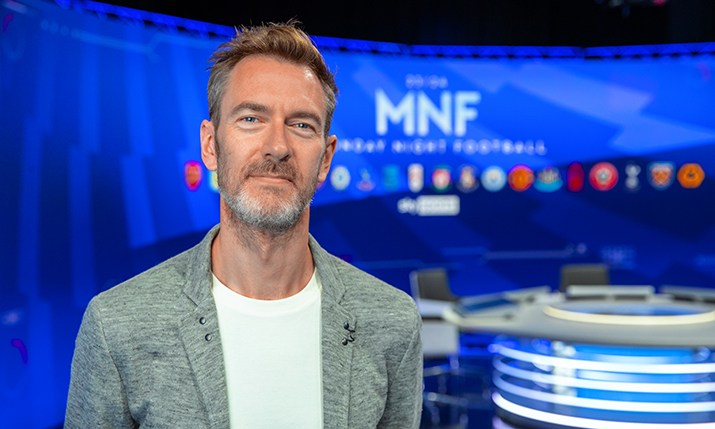
Ben Wickham: I want the teams to feel empowered to create great sports TV programmes
The studio also has an AR extension behind the camera that Sky Sports is calling the ‘fourth wall’.
“This means we can now spin the camera around and shoot back at the viewer. This is an entirely virtual space so we can include anything our heart desires. All of these things together means there is no story that we cannot tell or we haven’t got the technology for.”
For MNF specifically, the studio install is a real advance, for both the viewers and the pundits.
“It allows us to bring a bit more of Gary and Jamie into the studio,” he said, revealing that a movement coach has been brought in to help the talent make the best of the space that is now available to them.
“They can get up and they can move and be physical. They are sportsmen. We want to reflect a bit of that and make it feel joyful and fun. In terms of punditry, they can actually react in a space that has a bit more depth and width and be physical with the analysis.
“We have also hugely upgraded our capability for touchscreen analysis and telestration which allows us to replay parts of the game in a virtual space which in turn allows us to put a camera wherever we want in order to understand plays better, to retrospectively move players around to see how things might have been done differently.
“The pundits have complete access to that so that they can deliver a theoretical ‘this is what could have happened’, or ‘this is what it would have looked like if you were standing in a different place’.”
“It allows us to quickly bring a level of analysis, detail, and access to the game that viewers have never seen before.”
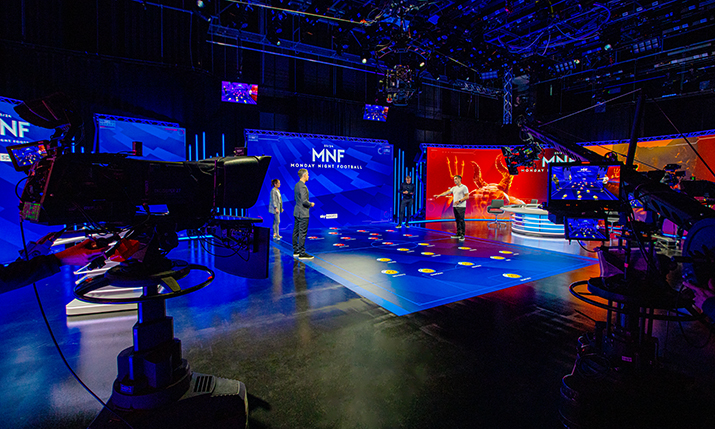
The Technology
Studio
- Five Grass Valley LDX 86n cameras upgraded with integrated Mo-Sys StarTrackers
- All the systems are connected to the Sky Studios’ IP core, allowing flexibility to utilise all control rooms depending on the production and the ability to expand and evolve the platform
- The LED is supplied by Roe. The main walls are from the Ruby range using 1.9mm and 2.3mm ties. The floor is Black Marble, similar to the type of floor used in major Light Entertainment shows, but with a matt finish for TV studio use
- The walls are driven by Helios Megapixel processing that supports Ghostframe
- A 4-point wire camera supplied as a custom unit by BATCAM with a Grass Valley camera and Mo-Sys tracker
- Touchscreens with Piero, controlled by Unity
Lighting
- All fixtures are either Robe or Arri, all with a CRI of 95+ giving full-colour temp control and colour. No gels are used, reducing single-use plastic
- Lighting control is from Sacn to each fixture giving us complete control and feedback during usage
- Control is via two ETC Apex 10s with Swisson Network switches, nodes and buffers.
- All lighting is LED
Sky director of group production engineering Kevin McCue, discussing the technology choices for the studio, explained that the number of suppliers has been kept deliberately low.
“That is generally a bit of a strategy that we are taking more broadly within Sky,” he said. “Purely because you can end up splitting your engineering competency over so many different vendors and products you can become a ‘jack of all trades, master of none.’
“The engineering design [for the studio] had some core architectural principles,” he continued. “Experience has taught us a lot of things about the way we evolve technology. We try not to lock ourselves into one design thing that can’t be changed. We have strategies that are at different levels of maturity and we didn’t want this studio to be excluded from this overall tech strategy. And more now than ever we are focused on infrastructure, availability, observability, sustainability, and security.”
Unreal Engine is part of the new studio but, because of the scale of the ambition, not in the way you might imagine.
“We took a view that Unreal Engine was going to be part of this conversation,” explained McCue, “But, managing a studio of this size, raw Unreal was not going to be feasible at this point in time for live production. We needed to create a level of control and infrastructure around Unreal so that we have the right level of predictability. Essentially, we have got Unreal sitting inside Viz 5.”
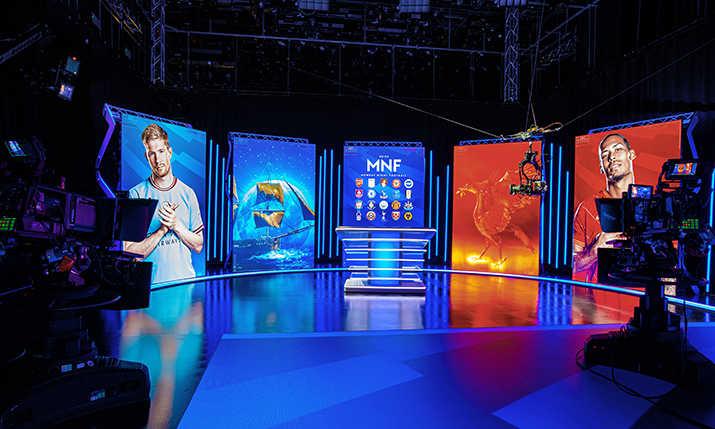
Choosing the right LED screens was a crucial part of the studio build too, he added
“We have installed a number of different types of screens from Roe. We did a big product shootout with all the various screen technologies. We went through a massive iteration process so that we got the right floor, the right totems, the right high-res wall and the right curved wall.
“In my engineering group, we take it very seriously. We try to view the value of the spend through a number of different lenses: the quality of the environment, the quality of the vendor, and how that vendor stands up to some of our Corporate Social Responsibility (CSR) code. We interrogate the vendor to ensure they are following Sky’s principles.”
Background and design
The original driver for the project, added Wickham, was a step change in production capabilities.
“We always want to innovate. I was casting my eye over the state of the sports broadcasting industry and I was seeing the things that we could be doing in the future and I wanted to make sure that we were able to bring that to our customers. I wanted to make sure that we had the space and the ability and the technology in place to give the on-screen talent a space or a canvas that we didn’t currently have. They were perfectly adequate studios that we could make great programmes in. But we were hitting the limit of what they could do technically.
“We decided to not just iteratively improve but to actually take a big step. To the point where we can’t even use all the tech straight away – but we have room to expand in the future.”
“The studio and the infrastructure are ready for 2110. That means we can quickly allow the use of the studio floor from any of our production control rooms. This gives us huge portability.”
The design and concept were created in-house, in collaboration between Sky UK and Sky Italy. Specialists were then brought in to help with specific elements.
“Once we had the concept of what the physical space would look like, the next stage for us was to go to the market and ask ‘what is everyone doing?’ We did a piece around what all the other broadcasters are working on including all the things that we can’t do now that we would like to do. We asked: what has no one done before? We had a concept but as far as possible we wanted to build it so that we don’t miss something that is going to happen in the industry in two years time. That was our gold standard – we don’t want to build this and then next year find out that someone has come up with something that we haven’t heard of.”
Experienced studio designers White Light were consulted during this process.
“They helped us out quite a lot with information on what technology is going somewhere and what isn’t. Sharing, for example, what is great and what is going to be really hard to integrate.”
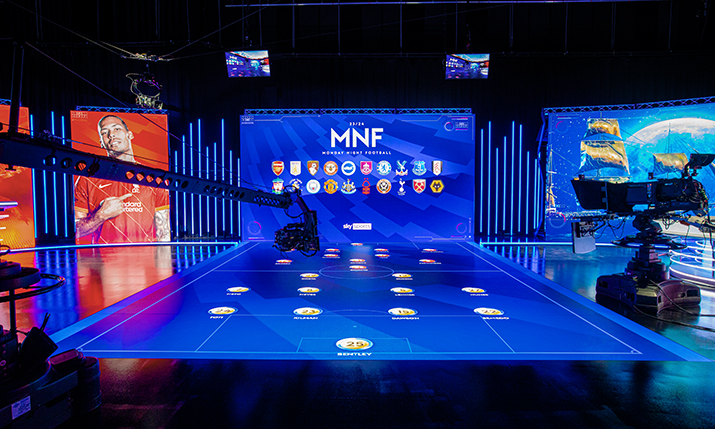
Graphics and infrastructure
Of course, graphics – 2D, 3D, virtual and augmented – are at the heart of the studio. McCue said his team looked very carefully at how they would manage the graphics environment.
“We have lots of Viz engines for the walls and cameras so we wanted to find a way that we could quickly adapt to software versions or plugins. The whole of the environment is managed by Ansible deployment automation technology that allows us to control operating systems and run automation scripts that can rapidly control all of the components of the graphics engine inside our environment. This means we can automatically and quickly do updates and testing.
“Ansible is key to how we will continue to evolve this studio,” he added. “It’s usually used in data centres. Through dashboards we can observe the health of all the components of the platform in one place, tracking trends and catching failures.”
“We are working closely with manufacturers and suppliers to ensure we can make everything work. The idea is that we build our own knowledge base.”
Although it won’t happen straight away, the studio will soon be part of Sky’s company-wide SMPTE ST 2110 transformation.
“The studio and the infrastructure are ready for 2110 even though it’s not hosted in that environment yet,” he said. “That means we can then quickly allow the use of the studio floor from any of our production control rooms. This gives us huge portability.”
For all the AR, VR, XR, IP and IT, however, it is something a lot more down to earth that pleases McCue the most.
“The floor monitors are completely wireless, including power,” he revealed, with a huge sense of satisfaction. “You have enough to deal with when it comes to cable bashing. So, the floor monitors are big 50-odd-inch screens on Unicol stands. They have batteries that give us 12 hours of electricity that powers the monitor and then we have 6G wireless transmitters that go on to the back of them. You can wheel them anywhere in the site that you want, in range of the 6G network.”
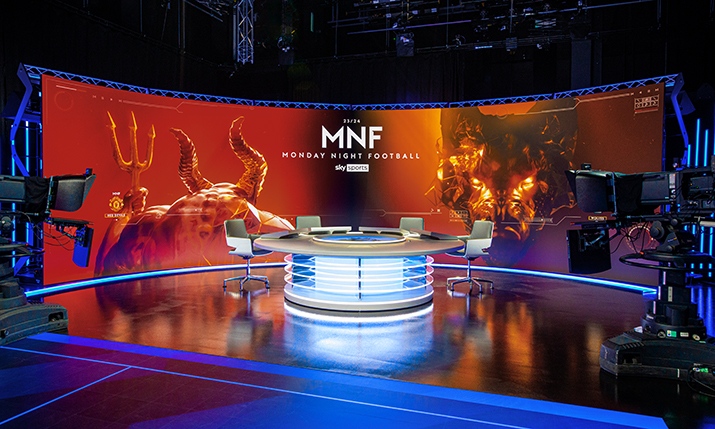
People
All the new tech is great, of course, but it still requires people to operate it, a fact not lost on either Wickham or McCue
“One of the things that we were really keen to do was to make sure that we have skills that are industry-leading,” said Wickham.
“Where we weren’t able to do things, or didn’t have the knowledge to do things, internally we have brought in people who can teach us. Some of the kit and tech is new so we have had to up-skill people. We are working closely with manufacturers and suppliers to ensure we can make everything work. The idea is that we build our own knowledge base.
“We do all of this ourselves. We use our own engineering teams. All of the software from a control and UI and UX perspective, we develop ourselves. Resource is always challenging but we have a great roster of engineering here.”
“We have put more technology and more opportunity into this studio than we currently know how to use!” he continues. “I am very keen that we don’t build to 100 per cent on day one. There are things we can do that we don’t fully know the use of yet, for example, Ghostframe [a technology that allows the user to decide which elements are visible to the human eye and which are visible only to the camera within a production frame, across chromakey, tracking, and video feeds].
“But we wanted to have it because we think that in a couple of years’ time that will be a standard industry thing. There is a lot of headroom with that studio. And we are learning what we can do with it. It will only get better.”

McCue added that the Sky people behind this project, codenamed ‘Greyhound’, deserve a lot of praise.
“The challenge has been making it all work together. It’s a confident, not shouty, set. But having a set that is confident means that the engineering has to be absolutely spot on in every single way. Dealing with the number and size of creative assets has become complicated. We have had to put all of our graphics engines onto high-performance storage which we have never had to do before.
“We do all of this ourselves. We use our own engineering teams. All of the software from a control and UI and UX perspective, we develop ourselves. Resource is always challenging but we have a great roster of engineering here.”
“It has been genuinely exciting to take up this challenge and develop something that is beyond even what I imagined it to be.”
A studio of this calibre deserves to be used. So, in addition to MNF and the US Open, will other shows and sports pres be based here? Absolutely. But not quite yet.
“The underlying point of the studio is that it is a flexible sports studio space,” reiterated Wickham. “It can absolutely be used for anything in any way. But we haven’t moved away from wanting to bring our viewers closer to the sport. We still fundamentally want to be on-site as much as we possibly can be. I think the studio will be used for special bespoke programming. We will certainly look to put other sports in there as the year moves on. But let’s get MNF launched first.”
And now that has happened, what is the verdict?
“I feel genuinely great about it,” concluded Wickham. “I wanted to make sure that we created a studio that we could hand over to all of the great production teams that we have got at Sky – whether that is technology, craft, creative or editorial – and say ‘here is something where you will not be limited by anything other than your imagination’. I want the teams to feel empowered to create great sports TV programmes. And it has been genuinely exciting to take up that challenge and develop something that is beyond even what I imagined it to be.”
Key People
Project Delivery
- Sarah Thornley, Operations Delivery Supervisor
- Jack Mooney, Senior Project Manager
Sky Creative
- Ceri Sampson, Group ECD, Brand & Design
- Harry Ward, Creative Director, News and Sport
- Jonathan Ryder Richardson, Set Design Lead
- Danny Yeomans, Design Director, Sports
- Jason Landau, Creative Director, Innovation
- Phil Madge, Innovation Design Lead
- Vincenzo Lagattolla, Head of Content Operations, Sky IT
- Luca Brioschi, VR/AR Manager
- Chris Atherton, Senior Real-Time Designer
- Colin Bucknell, Senior Real-Time Designer
- Sophie Brooks, Director of Production
- Sofie Leale, Executive Producer, News and Sport
- Nicky Chauhan, Senior Producer, Innovation
Engineering
Vladimir Repede, Technical Manager; Salil Kolamkanny, Technical Specialist; Emily Bergun, Associate Technical Specialist; Neville Smith, Technical Specialist; Regan Stewart, Delivery Manager; Gordon Murray, Principal Design Lead; Rory Hurren, Solution Architect; Oli Anderson, Production Engineering Specialist Manager; James King-Taylor, Production Engineering Shift Manager; Luc Nasiri-Marques, Senior Specialist Engineer; David Brazel, Solutions Architect; Peter Charalambous, Senior Systems Developer; Tim Blackler, Senior System Developer; Roger Cumner, Project Engineer; Martin Black, Project Engineer; Wayland Twiston-Davies, Senior Solutions Architect; David Maidwell, Senior Logistics Technician; James Dowling, Senior Logistics Technician; Matthew Hadlow, Logistics Technician; Rob Hughes, Logistics Co-ordinator; Giles Marlow, Asset Management Analyst; Suraj Plaha, Logistics Technician; Jimmy Rodrigues, Logistics Technician; Andrew Wootton, Logistics Technician; Stephen Reed, Senior Logistics Technician; Daniel Vickers, Wireperson; Josh Bartmeier, Wireperson; Patrick Boucaud, Senior Wireperson; Tom Wilson, Wireperson; Simon Armstrong, Software Engineer
Studios
Jonathan Craggs, Senior Technical Supervisor; David Adams, Operational Technical Specialist; Lee Jackson, Lighting Team Leader; Harry Woodman, Senior Graphics Operator; Nicholas Small, Senior Graphics Operator; Dan McMillan, Vision Mixer; Joe Crane, Camera Supervisor; Russ Houghton, Camera Supervisor; Aaron Harte, Senior Sound Supervisor; George Wiles, Senior Sound Supervisor
Operations
- James Clement, Director of Operations
- Gordon Roxburgh, Head of Production Technology
Movement Coach
- Polly Bennett

